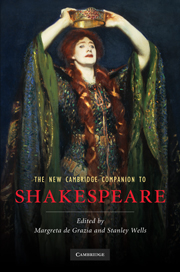Book contents
- Frontmatter
- 1 The traces of Shakespeare’s life
- 2 Shakespeare’s reading
- 3 Shakespeare’s writing: from manuscript to print
- 4 The theatre of Shakespeare’s London
- 5 The transmission of Shakespeare’s texts
- 6 Shakespeare and language
- 7 Shakespeare the poet
- 8 Shakespeare’s comedies
- 9 Shakespeare’s tragedies
- 10 Shakespeare’s English history plays
- 11 Shakespeare’s classical plays
- 12 Shakespeare’s tragicomedies
- 13 Shakespeare, religion and politics
- 14 Shakespeare and race
- 15 Shakespeare, sexuality and gender
- 16 Shakespeare on the stage
- 17 The critical reception of Shakespeare
- 18 Shakespeare and popular culture
- 19 Shakespeare and globalization
- 20 Shakespeare and media history
- 21 Shakespeare: reading on
- Index
1 - The traces of Shakespeare’s life
Published online by Cambridge University Press: 28 January 2011
- Frontmatter
- 1 The traces of Shakespeare’s life
- 2 Shakespeare’s reading
- 3 Shakespeare’s writing: from manuscript to print
- 4 The theatre of Shakespeare’s London
- 5 The transmission of Shakespeare’s texts
- 6 Shakespeare and language
- 7 Shakespeare the poet
- 8 Shakespeare’s comedies
- 9 Shakespeare’s tragedies
- 10 Shakespeare’s English history plays
- 11 Shakespeare’s classical plays
- 12 Shakespeare’s tragicomedies
- 13 Shakespeare, religion and politics
- 14 Shakespeare and race
- 15 Shakespeare, sexuality and gender
- 16 Shakespeare on the stage
- 17 The critical reception of Shakespeare
- 18 Shakespeare and popular culture
- 19 Shakespeare and globalization
- 20 Shakespeare and media history
- 21 Shakespeare: reading on
- Index
Summary
What are the key surviving traces, unadorned by local colour, of Shakespeare's life? The core set of these traces, of course, consists of the printing of his name as the author of his plays and poems. During his lifetime, eighteen of the plays now attributed to Shakespeare were printed in the small-format editions called quartos. Many such editions of plays in this period were issued without the name of the author - there was no equivalent to our copyright system, and publishers were under no legal obligation to specify on their title pages who wrote the texts they printed. (See Chapter 5.) By the second decade of the seventeenth century, it had become more or less routine to include the author's name, but it remains difficult at this distance to gauge the level of contemporary interest in particular playwrights: some contemporaries compiled detailed lists of the names of those they regarded as the pre-eminent playwrights in different genres; many others, to judge from surviving texts, seem to have been no more interested in the authors of plays than audiences today are interested in the authors of television shows. (See Chapter 3.) Only occasionally were there significant exceptions, and then as now for the same principal motive: profit. By 1597 seven of Shakespeare's plays had been printed, their title pages providing details of plot and of performance but not the identity of the author. After 1598 Shakespeare's name, spelled in various ways, began to appear on the title page of quartos, and indeed several plays almost certainly not authored by him were printed with his name.
- Type
- Chapter
- Information
- The New Cambridge Companion to Shakespeare , pp. 1 - 14Publisher: Cambridge University PressPrint publication year: 2010

